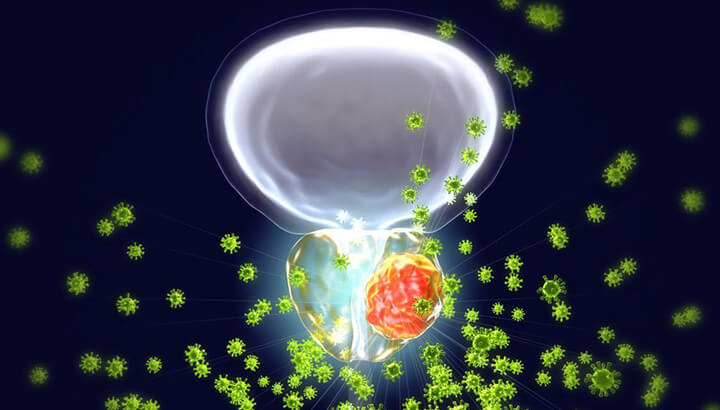
Prostate cancer develops in the prostate gland and is the most diagnosed male malignancy. It accounted for 1.3 million new cases worldwide in the year 2018; it is the third-leading cause of cancer death in men globally. In developing countries like India, there is an increasing trend in the incidence of prostate cancer.
The prostate is a small walnut-shaped gland in men and is responsible for the production of semen. It is located underneath the urinary bladder in front of the rectum.
Prostate cancer develops when cells in the prostate gland begin to grow in an uncontrolled way forming a tumor. About 90% of prostate cancers are adenocarcinomas in which the cancers develop from the gland cells that produce seminal fluid.
Prostate cancer is of two types:
Early prostate cancer usually causes no specific symptoms. As the cancer advances, one may experience the following symptoms:
Even though the exact cause of the development of prostate cancer is unknown, researchers believe that prostate cancer may develop due to sudden changes in the cells of the prostate gland. However, some factors may increase the risk of prostate cancer. These include:
Prostate cancer is asymptomatic during the early stages. So, any individual between 55 to 69 years of age with a family history of prostate cancer is recommended to undergo regular screening. Prostate cancer can be screened with the following tests:
If prostate cancer is suspected from initial examinations, the following tests may be recommended for further evaluation:
When these tests confirm the presence of cancer, it will be graded using the Gleason score. Higher grades are for aggressive cancers that are more likely to grow and spread quickly. Lower grades are for normal prostate tissues. If cancer has a high Gleason score, imaging test like whole-body bone scan, computerized tomography (CT) scan, and magnetic resonance imaging (MRI) is done to determine the extent of its spread.
The prostate cancer staging is done using the Tumour, Node, and Metastasis (TNM) staging system. It provides detailed information about:
Based on this system, the prostate cancer has the following stages:
Treatment options for prostate cancer are based on the aggressiveness of the tumor, the stage of cancer at the time of diagnosis, and overall health. Treatment modalities for prostate cancer are:
Observation/ Active surveillance: It does not help treat cancer, instead it helps to monitor the slow-growing tumors. Regular screening, routine follow-up blood tests, and rectal examinations are performed to monitor the progression of cancer. If the test results indicate cancer progression, then prostate treatments are decided to remove or destroy cancer.
Surgery: It is recommended when the cancer is situated locally in the prostate gland. Prostate surgery and surrounding lymph nodes surgeries are involved procedures. Types of prostate surgeries include:
Radiation therapy for prostate cancer: It uses high-energy radiation like X-rays to destroy the cancer cells. Depending upon the stage, the radiation therapy is used:
Depending on the stage of cancer, radiation therapy is given either externally through an external source or internally by placing a radiation source near the tumor to deliver high-dose rays.
Hormone therapy: It is used to block certain hormones that aid in the growth of cancer cells. Lowering androgen often makes prostate cancers shrink or make them grow slowly for a time. It is often used with other treatment options to prevent a recurrence.
Chemotherapy: This involves the use of potent drugs to stop the cancer cells from growing further or to destroy them. It is usually used for cancers that have spread beyond the prostate gland and are no longer responding to hormonal therapy.
Cryotherapy: This involves the usage of extremely cold temperatures to freeze and kill prostate cancer cells. It is recommended for patients with low-risk early-stage prostate cancer who cannot have surgery or radiation therapy.
Immunotherapy: It involves the use of specific drugs to stimulate a patient’s immune system to recognize and destroy cancer cells more effectively.
There is no absolute way to prevent prostate cancers. Managing certain risk factors may reduce the risk of developing cancer. These include:
Unlike other cancers, prostate cancers generally tend to grow slowly with relatively low risk and limited aggressiveness. The survival rates depend on the stage of cancer at the time of diagnosis. The average five-year survival rate for patients with stage I and II prostate cancer is 100%. The rate decreases to 31% for stage IV cancer patients. Advanced treatment options and healthy living habits will help in better outcomes.